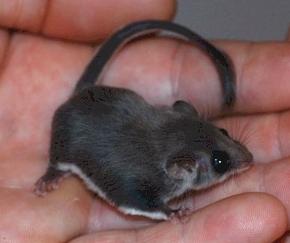Feather-tail sliding pouches
| Feather-tail sliding pouches | ||||||||||||
|---|---|---|---|---|---|---|---|---|---|---|---|---|

Feather Tail Glider ( Acrobates ) |
||||||||||||
| Systematics | ||||||||||||
|
||||||||||||
| Scientific name | ||||||||||||
| Acrobates | ||||||||||||
| Desmarest , 1818 |
The feather-tail glide pouches ( Acrobates ) are a genus of marsupials from the family of the dwarf glide pouches (Acrobatidae). A distinction is made between two types, the broad- footed feather-tail glide bag ( Acrobates frontales ) and the narrow-footed feather-tail glide bag ( Acrobates pygmaeus ). Their closest relatives are not the gliding glide pouches , but the non gliding feather- tail pouches ( Distoechurus pennatus ).
description
Feather-tail glide pouches, sometimes called Australia mouse flight pouches, are the smallest glidable marsupials and are among the smallest marsupials. Only the honey bucket ( Tarsipes rostratus ) and the thin-tailed sleep bucket ( Cercartetus concinnus ) are smaller . They reach a head body length of 50 to 70 millimeters and a weight of 8 to 18 grams. The long tail is provided with short, stiff hair on both sides, which gives it a feather-like appearance and which owes its common name to them. Between the limbs there is a rather narrow sliding membrane, which is provided with fringed hair on the edges. The Uropatagium is in contrast to the Fledertieren rudimentary regressed. Feather-tail glide pouches, like some narrow-foot pouch mice ( Sminthopsis ), are able to find support on smooth surfaces such as bark or leaf structures. You can even watch the animals in the zoo climbing vertically on panes of glass. This enables them to use the wavy, furrowed structure of the ball complexes below their feet, as well as the sweat glands between these "lamellae". The surface tension of the sweat results in capillary adhesion , as is the case when two panes of glass are connected by a thin film of water . The fur of these animals is gray-brown on the upper side, the underside is white.
distribution and habitat
Feather-tailed gliders are common on the Australian east coast, their habitat extends from the Cape York Peninsula to southeastern South Australia . Reports of occurrences in New Guinea are likely based on confusion. They occur in different habitats , mostly in forests (including rainforests and eucalyptus forests ), but also in grasslands with trees and in mountainous areas.
Way of life and food
Feather-tailed gliders are nocturnal animals. They are skilled climbers who can quickly move up and down the trees. With the help of their gliding membranes, they can glide up to 20 meters long, with the feather-like tail serving as a rudder. During the day they sleep in self-made leaf nests, in tree hollows, but sometimes also in nest boxes and other man-made dwellings, which can protrude up to 20 meters in height. They live together in groups of up to 20 animals, which, however, represent short-lived associations, and a ranking is not established. In times of lack of food, they sometimes fall into a torpor (cold rigor).
Feather-tailed gliders feed on insects and their larvae as well as nectar, protein-containing bee pollen and tree sap.
Reproduction
Females have a well-developed pouch with four teats. Two to four young animals are born after a gestation period of 18–20 days. These spend their first two months in the mother's pouch, after which they stay in the mother's nest for another month. Females become sexually mature at 8 months and males at 12 to 18 months. The highest known age of an animal in human care was seven years.
Systematics
On the basis of morphological characteristics, the dwarf gliding pouches (Acrobatidae) were placed in the family of the bilch pouches (Burramyidae) . According to molecular genetic investigations, the family of the dwarf glide pouches together with the honey pouch (Tarsipedidae), the glide pouch (Petauridae) and the ring pouch (Pseudocheiridae) form the superfamily of the Petauroidea. The two species of the genus were listed as one until recently ( Acrobates pygmaeus ). Only precise molecular-biological and morphological investigations led to the knowledge that there are two different species that occur sympatric in large parts of the distribution area .
threat
Feather-tailed gliders are sometimes found near humans and are considered common animals. They are not endangered species.
literature
- Ronald M. Nowak: Walker's Mammals of the World . Johns Hopkins University Press, 1999 ISBN 0-8018-5789-9
- Jamie M. Harris: Acrobates pygmaeus (Diprotodontia: Acrobatidae) . In: Mammalian Species . tape 47 (920) , 2015, pp. 32-44 , doi : 10.1093 / mspecies / sev003 ( abstract ).
Individual evidence
- ↑ a b c Ken Aplin: Family Acrobatidae (Feather-tailed Gliders and Feather-tailed Possum). Page 590 a. 591 in Don E. Wilson , Russell A. Mittermeier : Handbook of the Mammals of the World - Volume 5. Monotremes and Marsupials. Lynx Editions, 2015, ISBN 978-84-96553-99-6
- ^ Wrobel, M .: Elsevier's dictionary of mammals: in Latin, English, German, French and Italian . Elsevier. 2007.
- ↑ Rosenberg, HI & R. Rose: Volar adhesive pads of the feathertail glider, Acrobates pygmaeus (Marsupialia; Acrobatidae) . Can. J. Zool. 77. 1999. pp. 233-248
- ↑ Petzsch, H .: Urania Tierreich, 7 vol., Mammals. Urania, Stuttgart (1992) ISBN 3-332-00499-9 .
- ↑ Laura J. May-Collado, C. William Kilpatrick, Ingi Agnarsson: Mammals from 'down under': a multi-gene species-level phylogeny of marsupial mammals (Mammalia, Metatheria) . PeerJ . 2015 Feb 26; 3: e805. doi: 10.7717 / peerj.805 . eCollection 2015.
Web links
- photo
- Acrobates pygmaeus inthe IUCN 2013 Red List of Threatened Species . Posted by: Dickman, C., McKenzie, N. & Menkhorst, P., 2008. Retrieved January 22, 2014.

